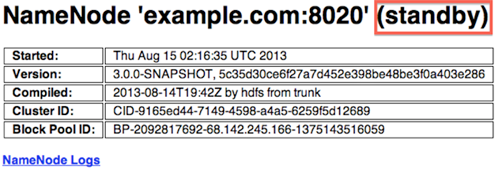Deploying a NameNode HA Cluster
To deploy a NameNode HA cluster, you must initialize JournalNodes, run the required configurations for HA on the NameNodes, and validate the HA configuration.
In this task, we convert a non-HA cluster to HA. We use NN1 to denote the original NameNode in the non-HA setup, and NN2 to denote the other NameNode that is to be added in the HA setup. If you are using more than one standby NameNode, repeat the steps for NN2 on NN3.
 | Note |
|---|---|
HA clusters reuse the NameService ID to identify a single HDFS instance (that may consist of multiple HA NameNodes). A new abstraction called NameNode ID is added with HA. Each NameNode in the cluster has a distinct NameNode ID to distinguish it. To support a single configuration file for all of the NameNodes, the relevant configuration parameters are suffixed with both the NameService ID and the NameNode ID. |


